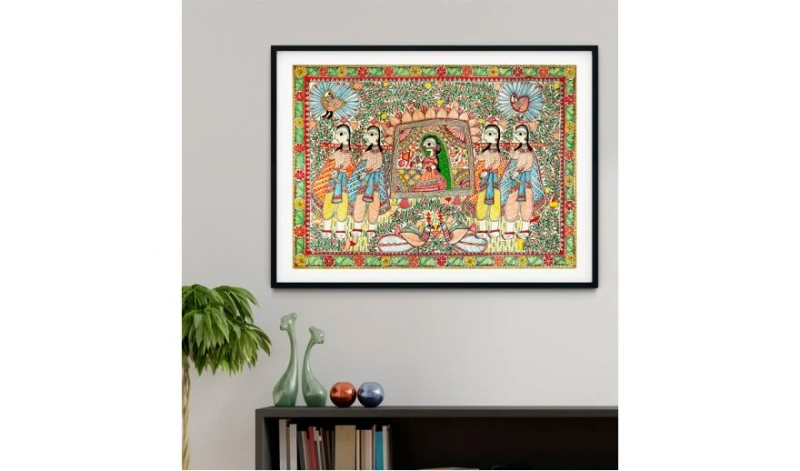India is home to many beautiful and unique art forms. One of the most popular and well-known art forms is the Madhubani painting. These paintings originated in the Mithila region of India and are known for their bold colors and intricate patterns. Madhubani paintings are not only beautiful but also have a lot of significance. They are traditionally made by women and are often used to depict scenes from Hindu mythology. The paintings are also said to bring good luck and prosperity to the home. If you are looking for a unique way to decorate your home, then Madhubani paintings are a perfect choice. In this blog post, we will explore the beauty and significance of these paintings.
What is Madhubani Art and Why is it Important to India?
Madhubani art is a type of Indian folk painting that originated in the villages of Bihar. Madhubani means "forest of honey" and these paintings are typically created on the walls of huts using natural dyes. The paintings often depict Hindu gods and goddesses, as well as scenes from the epic Mahabharata. Madhubani art is known for its vibrant colors and intricate patterns.
Madhubani paintings were traditionally made by women, who passed down their skills from generation to generation. In recent years, however, there has been a growing number of male artists who are taking up this art form. Madhubani art is now recognized internationally, and its popularity has led to a revival of interest in traditional Indian folk art.
History and Significance of Madhubani Art
Madhubani art is a form of painting that originated in the Madhubani district of Bihar, India. The name literally means "the blacksmith's art". Madhubani paintings are characterized by their use of bright colors and bold lines. They often depict scenes from Hindu mythology, such as the wedding of Krishna and Radha.
Madhubani paintings are typically done on walls or floors, using a variety of natural materials such as cow dung, clay, and vegetable dyes. The paintings are usually made during festivals or special occasions, and they often tell a story or convey a message.
Madhubani art has a long history, dating back to the 12th century. It is believed to have been influenced by the Pahari school of painting, as well as by Rajasthani and Mughal art. Madhubani paintings reached their peak of popularity during the 16th and 17th centuries when they were often commissioned by royalty and nobles.
The British colonists who came to India in the 18th century were fascinated by Madhubani paintings, and many of them collected examples of the genre. Today, Madhubani paintings are appreciated for their beauty and uniqueness, and they are becoming increasingly popular as decorative items in homes around the world.
The Different Styles of Madhubani Art
Madhubani art is an age-old Indian painting tradition that dates back to the 12th century. The name ‘Madhubani’ comes from the village of Madhubani in the Mithila region of Bihar, where this form of painting originated. This type of painting is also known as ‘Mithila art’ or ‘Bihar school of painting’.
One of the most unique things about Madhubani art is the way it is traditionally created. Paintings are not done with brushes; instead, they are made using a variety of tools including fingers, twigs, matchsticks, and even buffalo horn. This gives Madhubani paintings a distinctive textured look.
Madhubani art is not just about pretty pictures; it also has a deep cultural significance. In Mithila culture, women are responsible for creating all the artwork in the home. This includes everything from painting the walls to making embroidery and block-printed fabrics. Madhubani paintings are often used as ceremonial decorations during weddings and other important occasions.
If you’re looking for a truly unique piece of art to add to your home décor, then a Madhubani painting is definitely worth considering!
How to incorporate Madhubani Art into your home as decor?
Mithila or Madhubani paintings are the most unique and beautiful decorative paintings that you can use to glam up your home. These paintings are not only aesthetically pleasing but also have a deep cultural significance.
Madhubani paintings originated in the Mithila region of India and Nepal. They are traditionally created by women using natural dyes and pigments on walls and floors during religious and festive occasions. The motifs and patterns used in Madhubani paintings depict scenes from nature, Hindu mythology, and the daily life of the Mithila people.
Madhubani paintings are usually done in bright colors with a bold geometric style. You can incorporate them into your home decor by hanging them on the walls or using them as table runners or coasters. You can also frame them and display them on shelves or mantelpieces.
If you want to add a touch of Madhubani art to your home, there are many ways to do it. Just be creative and have fun!
Madhubani art is truly unique and makes for beautiful home décor. Not only are these paintings visually stunning, but they also hold great significance. Madhubani paintings depict the various aspects of Hindu mythology and help to tell important stories. They are also said to bring good luck and fortune to those who display them in their homes. If you're looking for a way to add some extra glamour to your home, consider investing in a Madhubani painting.


